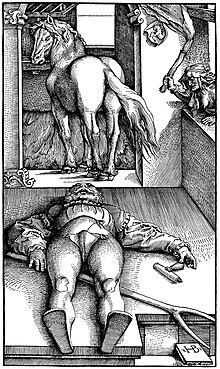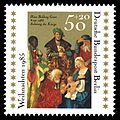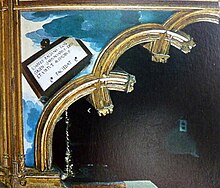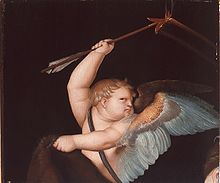Hans Baldung


Hans Baldung (* 1484 or 1485 in Schwäbisch Gmünd ; † September 1545 in Strasbourg ), also known as Hans Baldung Grien after the color he preferred, was a German painter , draftsman and engraver at the time of Albrecht Dürer , who also designed numerous woodcuts and made stained glass . He is one of the outstanding artists of the Renaissance in German-speaking countries.
Life
Hans Baldung was born in the former Free Imperial City of Schwäbisch Gmünd . Although he came from a family of scholars who had moved to Strasbourg around 1490 , he probably began his apprenticeship at the age of fifteen in the workshop of a Strasbourg master.
Nuremberg
In 1503 Hans Baldung immigrated to Nuremberg in order to develop himself further with Albrecht Dürer . Here he was given the nickname "Grien", according to legend, "the green one", because he liked to wear green clothes and generally preferred the green color; in this way they wanted to distinguish him from the other journeymen in the workshop with the names Hans, Hans Schäufelein and Hans Süss von Kulmbach . He became Dürer's most important employee and headed his workshop during Dürer's absence. He remained lifelong friendship with the 15-year-old when he left Nuremberg in 1506. Dürer held him in high regard and, for example, gave the painter Joachim Patinir the “Grünhansen's thing” on his trip to the Netherlands in 1521 , which means woodcuts made by Baldung in Dürer's workshop. Even during his lifetime he was seen as the real successor of Dürer and after his death received a lock of Dürer's hair. Towards the end of his time in Nuremberg, he was allowed to carry out his first commission in his own name, namely the production of two winged altars as initial fittings for the Maria Magdalena chapel of the bishop's residence on the Moritzburg in Halle / Saale, which was then carried out from 1608 to 1838 in Hallesches Dom stood; there were the three king altar from 1506 and the Sebastian altar from 1507.
Strasbourg 1509 to 1512
In the spring of 1509 Baldung returned to Strasbourg and acquired citizenship there. In 1510 he was accepted as a master by the “zur Steltz” guild and opened his own workshop. He married Margarete Herlin, the daughter of a wealthy citizen and enjoyed growing popularity and increasing demand as a painter. He began to sign his works with the monogram HBG in ligature , which he mostly used for the rest of his creative period. His style became more and more mannerist .
Freiburg 1512 to 1518
In 1512, Hans Baldung was commissioned by the Münster keepers in Freiburg im Breisgau to design a convertible altar for the recently completed late Gothic choir of the Minster of Our Lady , consisting of four panels with a scene from the life of Mary (when closed), a central panel with the coronation of Mary and two wings with the twelve apostles (with the wings open), another painted back with the crucifixion of Jesus on the central panel and two saints on each of the two wings, plus a painted predella with the portrait-like busts of the cathedral caretakers in prayer before Mary as the patroness of Münster. This altar was to be the high point of his early work and also his main work. For this reason he moved to Freiburg with his wife and set up his workshop in the local barefoot monastery of St. Martin . During his time in Freiburg until 1518, he made several altars and devotional pictures, woodcuts and designs for church windows, etc. a. for furnishing the chapels of noble families in the ambulatory of the cathedral as well as for the series of glass windows of the Freiburg Charterhouse .
Strasbourg 1518 to 1545
Because of the plague ruling in Strasbourg, Hans Baldung did not return to Strasbourg until 1518, where he again acquired citizenship. He achieved high social prestige and prosperity in Strasbourg. From 1533 to 1534 he held the office of lay judge in his guild and even became a councilor in 1545, the year of his death.
Picture themes
Hans Baldung created numerous altarpieces by 1520. After that, major church commissions declined, so that he worked more and more for private art lovers, which had an impact on the subject matter of his pictures. Religious pictorial themes still appear in his post-Reformation oeuvre, mainly Madonna and devotional images; however, new topics were also added, including beauty and death, witches, horses, history and genre pictures and portraits . In his works from the late period, it becomes particularly clear that Hans Baldung lends the previously customary pictorial motifs new accents in terms of content and seeks stronger artistic expression. The Karlsruhe sketchbook with more than 100 silver pen drawings from the period between 1511 and 1545 deserves a special mention .
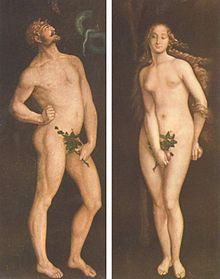
Beauty and death
The Three Graces, around 1543 ( Museo del Prado Madrid)
A favorite subject was the beauty and eroticism of naked people, especially women. Baldung created a beauty cult in numerous variations for which there were hardly any predecessors in Germany. The woman is portrayed as Eve , an ancient goddess , a witch or a seductress. Often, however, these embodiments of blooming life stand in contrast to the memento mori , the threat of inevitable death in the form of gruesome skeletons. The aspect of eroticism is also reflected in an examination of ancient erotic texts. Baldung's painting Death and the Maiden from 1517 is considered to be the earliest pictorial representation of pubic hair in modern European times .

Witches
Witches' Sabbath, 1510 ( Kupferstichkabinett Dresden )
New year greeting with three witches: THE COR CAPEN EIN GVT JAR, 1514 (Musée du Louvre Paris)
Standing witch with monster, 1515 ( Staatliche Kunsthalle Karlsruhe )
Two Witches, 1523 ( Städelsches Kunstinstitut Frankfurt)
Baldung often portrayed witches, a topic that was very much noticed in Strasbourg at the time. The Strasbourg humanists studied witchcraft and the Strasbourg bishop was involved in the witch hunt. Typically these paintings were small-format, a series of enigmatic, often erotic allegories and mythological works. Baldung's interest in witchcraft continued until the end of his career. From 1510 he created numerous works in which witches are depicted lascivious, seductive and at the same time evil. These works were not only copied en masse as woodcuts, but were also intended as pen drawings for individual clerics, such as the New Year's greeting from 1514 (Musée du Louvre, Paris).
Horses
Study of Unicorn, 1544 ( British Museum London)
Baldung's images of horses leave the sacred motifs behind. A sophisticated perspective study with a horse and groom, which was made around 1544, serves as an example. The shortened body of the man in armor lies stretched out on the floor in front of a stable. The rising image space is constructed as a stage. On the threshold to the next room stands a mare who seems to have struck the man down and looks at him maliciously. On Picasso's masterpiece Guernica , a screaming horse appears, which Picasso took over from Hans Baldung, as does the old witch's torch at the top right of the picture. In a woodcut sequence with wild horses from 1534, excited stallions bite each other in the neck while fighting for a mare and attack each other. In the Renaissance, horses symbolized the instinctual nature of humans.

Portraits
Portrait of a Bearded Man, 1514 ( National Gallery (London) )
Portrait of a Young Man, 1515 ( Kunsthistorisches Museum Vienna)
Portrait of a Young Man, 1526 ( Musée des Beaux-Arts de Strasbourg )
In the tradition of his role model Albrecht Dürer, Hans Baldung began portraiture very early, albeit in his own very self-confident style. His first work was a self-portrait , which he probably made at the beginning of his journeyman time in Nuremberg (around 1503) with a pen and brush in front of a mirror. In the Strasbourg period from 1518 onwards, he received his commissions mainly from noble families, the educated Strasbourg bourgeoisie as well as from the so-called Old Believers and the Reformed . Recognized portraits from the years 1513 to 1538 include:
• 1509 Young Man with a Rosary (Royal Collection Windsor)
• 1509 Portrait of a Young Man (Karlsruhe)
• 1513 portrait of Count Ludwig zu Löwenstein
• 1514 Portrait of a Bearded Man (National Gallery London)
• 1515 portrait of a young man (Kunsthistorisches Museum Vienna)
• 1515 portrait of Count Christoph I of Baden (Alte Pinakothek Munich)
• 1517 Portrait of Count Palatine Philip the Warrior (Alte Pinakothek Munich)
• 1518 head of an old man
• 1526 Portrait of a Young Man (Musée des Beaux-Arts Strasbourg)
• 1526 portrait of a 29-year-old man (Germanisches Nationalmuseum Nürnberg)
• 1526 portrait of Adelberg III. from Bärenfels (Augsburg?)
• 1530 Portrait of a Lady (Madrid)
• 1538 portrait of Ambrosius Volmar Keller.
Self-portraits
Portrait of Johannes Rudolfinger (left) with self-portrait by Hans Baldung from 1534. Double woodcut from: Sixtus Dietrich, Epicedion Thomae Sporeri , Strasbourg 1534 ( Augsburg State and City Library )
Only five real self-portraits by Hans Baldung are known:
• 1503 pen drawing with shaggy hat (Kunstmuseum Basel)
• 1506 self-portrait integrated in the three king altar of Halle / Saale (Gemäldegalerie Berlin)
• 1507 self-portrait integrated into the Sebastian altar in Halle / Saale (Germanisches Nationalmuseum Nürnberg)
• 1516 head with red beret on the crucifixion tablet of Freiburg (Freiburg Cathedral)
• 1534 Last self-portrait by Hans Baldung on the double woodcut from Sixtus Dietrich, Epicedion Thomae Sporeri, Strasbourg 1534 (Augsburg State and City Library).
In his graphic work there is also a self-portrayal as a voyeur on the first sheet of the woodcut series “Wild Horses” from 1534 (Germanisches Nationalmuseum Nürnberg).
Signatures and monograms
In the first years of his independent activity, Hans Baldung signed his works with the simple monogram * HB * (Hans Baldung), and from 1510 with the unmistakable ligated * HBG * (Hans Baldung Grien). The signature is often integrated somewhere in the picture, sometimes on a small board and with the date. One gets the impression that he used his monogram not only as a label, but also as advertising, for example when he inserts his own scene in the middle of the picture, as in the case of the little boy with a monogram on the Freiburg crucifixion board (1516) or the monkey with a monogram in the first woodcut of the series with the wild horses (1534). In the case of the Freiburg high altar, Hans Baldung even uses a caption on the back of the predella with the minster caretakers, including the crypto signature in the name of the minster attendant Nikolaus Scheffer, to refer to his work: “Johannes (Baldung) created this work - in the year of salvation, 1516 "; and the text on the inscription panel in the right gusset of the predella is even clearer, where it translates as: "Hans Baldung called Grien, the Gmünder, created this with the help of God and out of his own ability".
Works
In addition to the graphic works, portraits and self-portraits listed above, there is a compilation of the most famous paintings by Hans Baldung, listed according to their storage locations:
- Aschaffenburg, Johannisburg Castle
- The crucifixion of Christ , around 1535
- Aschaffenburg Dagger Madonna (actually: Lucretia)
- Augsburg, State Gallery
- Two altar wings (Charlemagne; Saint George)
- Bamberg, New Residence
- The Flood , 1516
- Basel, Kunstmuseum Basel
- The birth of Christ , 1510
- The crucifixion of Christ , 1512
- Saint Anna Selbdritt , around 1512/13
- The Holy Trinity with Our Lady of Sorrows , around 1513 to 1515
- Death and the Maiden , 1517
- Death and the Woman , around 1517
- Portrait of Adelberg III. von Bärenfels, 1526
- Berlin, Gemäldegalerie
- The Three Kings Altar , around 1506/07
- The crucifixion of Christ , 1512
- Portrait of Count Ludwig zu Löwenstein , 1513
- The Lamentation of Christ , around 1516
- Head of an old man , around 1518/19
- Pyramus and Thisbe , around 1530
- Mary with the Child and an Angel (Grunewald Madonna), around 1539
- Loth (fragment)
- formerly Berlin, Deutsches Museum
- The Crucifixion of Christ , around 1520 (attributed - probably destroyed in 1945)
- Bielefeld, Oetker Collection
- Portrait of Count Georg I of Erbach, 1533
- Budapest, Szépmüvészeti Múzeum
- Our Lady of Sorrows , around 1516
- Adam. Eva , around 1520 to 1525
- Cleveland, Cleveland Museum of Art
- The mass of St. Gregory , around 1511
- Coburg, Veste Coburg
- The Capture of Christ , around 1518-1520
- Darmstadt, Hessisches Landesmuseum Darmstadt
- Christ as a gardener , 1539
- Dessau, Anhaltische Gemäldegalerie
- The Adoration of the Magi , 1510
- formerly Dessau, Anhaltische Gemäldegalerie
- Saints Sebastian, Rochus and Christophorus , around 1510 (lost in the war)
- Dresden, Old Masters Picture Gallery
- Erfurt, Angermuseum
- Scenes from the creation story
- Florence, Museo Nazionale del Bargello
- Death and the Maiden , around 1531
- Florence, Galleria degli Uffizi - Uffizi Gallery
- Adam
- Eve
- Frankfurt am Main, Städelsches Kunstinstitut
- The Baptism of Christ , around 1518
- Two weather witches , 1523
- The birth of Christ , around 1530 to 1535
- Winged altar of St. John the Baptist
- Freiburg im Breisgau, Augustinian Museum
- Christ as the Man of Sorrows , 1513
- Mary with the Child , 1520
- Cupid with arrow
- Freiburg im Breisgau, Munster of Our Lady
- High altar , 1512–1516
- Schnewlin Altar, around 1514
- Hampton Court, Royal Collection
- Portrait of a Young Man, 1509
- Gotha, castle museum
- Judith with the head of Holofernes , around 1530
- Innsbruck, Ferdinandeum
- The Holy Family with Angels , 1513
- The Lamentation of Christ , around 1513
- Karlsruhe, State Art Gallery
- Margrave Christoph I of Baden with his family in adoration of St. Anna Selbdritt, around 1510 (so-called Margrave panel )
- The Unequal Lovers , 1528
- The Nativity , 1539
- Lot and his daughters (around 1530/40)
- Kassel, Old Masters Picture Gallery
- Hercules and Antaeus , 1531
- Kreuzlingen, Kisters collection
- The Holy Family , 1507
- Leipzig, Museum of Fine Arts
- The Seven Ages of Woman , 1544
- Liverpool, Walker Art Gallery
- The Unequal Lovers , 1527
- London, National Gallery
- The Holy Trinity , 1512
- Portrait of a Man , 1514
- Madrid, Prado Museum
- Diptych (left wing: The Harmony of the Three Graces ; right wing: The ages of women ), around 1540 to 1545
- Madrid, Thyssen-Bornemisza Museum
- Portrait of an elegant woman , around 1530
- Adam and Eve , 1531
- Merion, Pennsylvania, The Barnes Fondation
- Mary with the Child , around 1532 to 1539
- Mainz, State Museum Mainz
- Adam . (attributed)
- Eve . (attributed)
- Munich, Alte Pinakothek
- Portrait of Margrave Christoph I of Baden, 1515
- Portrait of Count Palatine Philip the Warrior, 1517
- The Nativity , 1520
- Portrait of the Strasbourg Johanniter-Komtur Balthasar Gerhardi, 1528
- Allegorical female figure with music book, viol and cat , 1529
- Allegorical female figure with mirror, snake, deer and hind , 1529
- Münster, LWL State Museum for Art and Cultural History
- Saint Verena , around 1516
- New York, Metropolitan Museum of Art
- Saint John the Evangelist on Patmos , around 1511
- Nuremberg, Germanic National Museum
- The Sebastian Altar , 1507 (loan from the city of Nuremberg)
- The rest on the flight into Egypt . around 1515/16 (loan from the city of Nuremberg)
- Mary with the child in the room , around 1516
- Judith with the head of Holofernes , 1525
- Portrait of a 29-year-old man , 1526
- Mary with the Child , 1530
- Mary with the Child (Madonna with the Parrot) , 1533
- Ottawa, National Gallery of Canada
- Eve, the Serpent and Death , around 15210 to 1525
- Otterlo, Rijksmuseum Kröller-Müller
- Venus with Cupid , around 1525
- Paris, Musee National du Louvre
- Phyllis and Aristotle , 1503
- Knight, Maiden and Death , around 1503 to 1505
- New year's greeting with three witches , 1514
- Poznan, Muzeum Narodowe
- Lucretia , around 1530
- Prague, Narodni Gallery
- The torture of Saint Dorothea , 1516
- Schwabach near Nuremberg, parish church
- Saint Catherine , around 1503/04
- Saint Barbara , around 1503/04.
- Stockholm, National Museum
- Mercury as a planet god , around 1530 to 1540
- Strasbourg, Musée de l'Œuvre Notre-Dame
- Portrait of the canon Ambrosius Volmar Keller , 1538
- Mary with the child in the vine arbor , around 1540 to 1545
- Self-portrait
- Saint Matthias , around 1530
- Saint George , around 1530
- Dormition of Mariaä , around 1525 (attributed)
- Stuttgart, State Gallery
- Christ as the Man of Sorrows , around 1520
- Portrait of Hans Jacop Freiherrn zu Morsperg and Beffert, 1525
- Vercelli, Museo Civico
- Maria with the child , around 1518/19
- Warsaw, Muzeum Narodowe
- Hercules and Antaeus , 1530
- Washington, National Gallery of Art
- Saint Anna Selbdritt and John the Baptist , around 1511
- Weimar, State Art Collections
- The Sacrificial Death of Marcus Curtius , 1530
- Vienna, picture gallery of the Academy of Fine Arts
- The rest on the flight into Egypt , around 1513
- Vienna, Art History Museum
- The three ages of woman and death , around 1510
- Portrait of a Young Man , 1515
- Whereabouts unknown
- Venus and Amor , (formerly Langenargen, Purrmann Collection)
Exhibitions
- 2019/20: Hans Baldung Grien - holy | unholy , Great State Exhibition Baden-Württemberg, Kunsthalle Karlsruhe
- 2016/17: Master of the woodcut: Hans Baldung Grien in the Augustinermuseum , House of the Graphic Collection, Freiburg
- 2007: Witches' lust and the fall of man. The strange fantasies of Hans Baldung Grien , Städelmuseum Frankfurt
- 2011: Hans Baldung, called Grien - Master of the Dürer period , drawings and graphics, Gemäldegalerie Berlin
- 2001/02: Hans Baldung Grien , exhibition in the Augustinermuseum Freiburg im Breisgau.
literature
- Oskar Eisenmann: Grien, Hans Baldung . In: Allgemeine Deutsche Biographie (ADB). Volume 2, Duncker & Humblot, Leipzig 1875, pp. 17-19.
- Hermann Schmitz : Hans Baldung, called Grien , Bielefeld and Leipzig, 1922
- Carl Koch: The drawings by Hans Baldung Griens . Deutscher Verlag für Kunstwissenschaft, Berlin 1941 with an addition from 1953 in: Kunstchronik, Central Institute for Art History in Munich, issue 11, November 1953, pp. 297–302.
- Carl Koch: Baldung-Grien, Hans. In: New German Biography (NDB). Volume 1, Duncker & Humblot, Berlin 1953, ISBN 3-428-00182-6 , pp. 554-558 ( digitized version ).
- MC Oldenbourg: The book woodcuts by Hans Baldung Grien , Koerner Verlag, Baden-Baden 1962.
- Matthias Mende: The graphic work. Complete picture catalog of the individual woodcuts, book illustrations and copper engravings . Uhl, Unterschneidheim 1978.
- Gert von der Osten: Hans Baldung Grien. Paintings and documents . German publishing house for art history, Berlin 1983.
- M. Consuelo Oldenbourg: The Buchholzschnitte of Hans Baldung Grien - A bibliographical directory of their uses . (Studies on German art history). Valentin Koerner, Baden-Baden 2 1985.
- Christian Müller: The portrait of the dead Erasmus of Rotterdam. In: Bulletin for the members of the Society for Swiss Art History, Vol. 41, Issue 2, 1990, pp. 202–217.
- Katharina Siefert: Hans Baldung Griens Karlsruhe witch drawing. A reinterpretation . In: “Critical Reports” 25., Marburg 1997, 3, pp. 69-77
- City of Freiburg im Breisgau / Saskia Durian-Rees (ed.): Hans Baldung Grien, catalog of the exhibition in the Augustinermuseum Freiburg October 19, 2001 to January 15, 2002, Freiburg 2001.
- Sibylle Weber on the brook: Hans Baldung Grien (1484 / 85–1545). Images of Mary in the Reformation , Regensburg: Schnell & Steiner 2006 (= Studies on Christian Art; Vol. 6).
- Sabine Söll-Tauchert: Hans Baldung Grien (1484 / 85–1545) - self-portrait and self-staging . Böhlau Verlag, Vienna and Cologne 2010, pp. 167–233; 279-292.
- Holger Jacob-Friesen / Oliver Jehle (eds.): Hans Baldung Grien. New perspectives on his work , Deutscher Kunstverlag, Berlin 2019, ISBN 978-3-422-97982-6 .
- Holger Jacob-Friesen (Ed.): Hans Baldung Grien - holy, unheilig, Deutscher Kunstverlag, Berlin 2019, ISBN 978-3-422-97981-9 .
Web links
- Literature by and about Hans Baldung in the catalog of the German National Library
- Works by Hans Baldung at Zeno.org .
- [1]
- Works in the Web Gallery of Art
- Helmut Perseke: Hans Baldung's work in Freiburg (research on the history of art on the Upper Rhine 3/4), Freiburg 1941 .
- Hans Baldung: List of works of art by date
Individual evidence
- ↑ Kindler's Malereilexikon, Vol. 1, p. 181
- ^ Carl Koch: Baldung Grien, Hans . In: Neue Deutsche Biographie (NDB) Vol. 1, Berlin 1953, pp. 554ff.
- ↑ Heike Mittmann: The Minster of Our Dear Lady in Freiburg - The high altar
- ^ Sebastian Bock: HOC OPVS FACTVM - Hans Baldung Grien and the high altar of the Freiburg Minster . In: Münsterblatt 2016 (No. 23) pp. 19–27
- ↑ Holger Jacob-Friesen (Ed.): Hans Baldung Grien - holy, unholy . Deutscher Kunstverlag, Berlin 2019
- ↑ Michael Sims: Adam's Navel and Eve's Rib: An Exploration of the Human Body
- ↑ Sabine Söll-Tauchert: Hans Baldung Grien (1484 / 85-1545) - self-portrait and self-staging . Böhlau Verlag, Vienna and Cologne 2010, p. 234ff .; 245ff .; 257
- ↑ Rose-Maria Gropp: The horses of Hans Baldung Grien . In: FAZ.NET November 6, 2016
- ↑ Holger Jacob-Friesen (Ed.): Hans Baldung Grien - holy, unholy . Deutscher Kunstverlag, Berlin 2019
- ↑ Sabine Söll-Tauchert: Hans Baldung Grien (1484 / 85-1545) - self-portrait and self-staging . Böhlau Verlag, Vienna and Cologne 2010, pp. 201ff .; 225ff .; 243ff; 279-292
- ↑ Sabine Söll-Tauchert: Hans Baldung Grien (1484 / 85-1545) - self-portrait and self-staging . Böhlau Verlag, Vienna and Cologne 2010, pp. 202–213; 247ff.
- ↑ On the Hexing of Art . In: FAZ , March 11, 2011, p. 35
| personal data | |
|---|---|
| SURNAME | Baldung, Hans |
| ALTERNATIVE NAMES | Baldung called Grien, Hans; Baldung Grien, Hans |
| BRIEF DESCRIPTION | German painter, draftsman and engraver |
| DATE OF BIRTH | 1484 or 1485 |
| PLACE OF BIRTH | Schwäbisch Gmünd |
| DATE OF DEATH | September 1545 |
| Place of death | Strasbourg |











